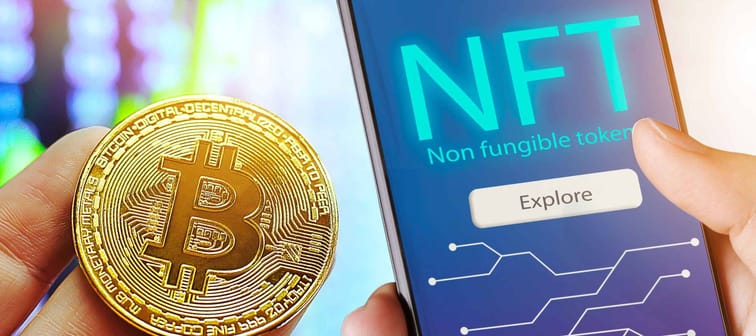What does NFT mean?
The acronym NFT stands for Non-Fungible Token. Non-fungible means something unique, that cannot be exchanged for something that is the same because there is nothing the same! This is different from other cryptocurrency assets like Bitcoin, which is fungible because you can exchange Bitcoin for another Bitcoin that is identical and equivalent.
NFT Example
One of the most popular examples of an NFT is the very first tweet, which recently sold for nearly $3 million dollars. If you’re wondering why someone would want to own something like a tweet, which you can read and enjoy without spending millions of dollars, think of it the same way you do precious art. Anyone can view the Mona Lisa in the Louvre, but only one (in this case, the French government) can own it.
In fact, art is the most popular use of NFTs right now, with some artists making multi-six figure incomes from NFTs this year. NFTs allow artists to be paid directly for their work, and NFT marketplaces let their art be seen by thousands of people who would not find it otherwise. Purchasing NFTs of digital art from artists can help them earn a living from their work, and continue to create and build their careers.
Other examples of NFTs are:
- Digital items
- Unique fashion item
- Domain name
- Social media post
- Video footage of an event
- Collectible
- A ticket or coupon
- A contract
How does it work?
An NFT uses blockchain technology to store information in a way that it cannot be changed or altered. When an NFT is minted (created) all the information about that NFT becomes a block on the Ethereum blockchain. When the NFT is sold, another block about that transaction is added to the blockchain, and so on. This way the entire history of an item is part of the object, so there is no mistaking its authenticity or ownership.
As of right now, almost all NFTs exist on the Ethereum blockchain, which uses a public ledger. This is how you can verify ownership of any item – it’s there for the world to see!
What are NFTs used for?
NFTs are used to store information about a physical or digital item. Right now NFTs are being heralded as the best way to identify the owner of a particular object, but you can include a lot more information on the blockchain.
For example, if you were to use an NFT for a deed for a car, it would contain information about the vehicle’s make, model, accident history, and more. Likewise, the NFT for fair trade coffee will contain information about the origin of the bean or even its caffeine content.
In the future, we will likely see NFTs used for everything from concert tickets to real estate contracts to medical records. As for right now, they are primarily being used for art and digital items in video games.
How can I buy an NFT?
As of right now, you can only purchase an NFT on a marketplace. Most sell digital art, but will occasionally sell ownership of digital assets, like tweets. NFT’s are built on the Ethereum blockchain, so all bids and sales are done with Ether as payment. To buy an NFT, you’ll need to be familiar with trading cryptocurrency and using it for transactions.
You can also only buy NFTs on NFT marketplaces. There are a few reputable ones including:
- SuperRare
- OpenSea
- Rarible
- Foundating
- Nifty Gateway
It’s also possible to buy an NFT directly from a creator. However, most people choose to use NFT marketplaces that allow bidding on items and protect both the buyer and the seller in the transaction.
Buying an NFT in 5 easy steps
Buying an NFT is fairly straightforward, particularly if you’re already invested in cryptocurrency and understand how it works. If you’re not, you should get familiar with buying cryptocurrency and transferring it from one wallet to another before you enter the world of NFTs.
Step 1: Open an account with a cryptocurrency trading platform.
If you don’t already have one, open an account with a cryptocurrency exchange platform. NFT marketplaces only trade in cryptocurrency, usually Ether, so you will have to have an account on a cryptocurrency trading platform to convert your CAD dollars into crypto.
Step 2: Exchange your CAD for ETH
NFTs are created on the Ethereum blockchain, so they are usually priced in Ether. In order to buy an NFT, you will need to convert your CAD dollars to ETH. This can be done at any time on your cryptocurrency exchange platform. Cryptocurrency prices are still very volatile, so try to exchange your CAD for ETH when you can get a good price! Most NFTs with any long term value are fairly expensive, so try to begin with at least 1 Ether coin (approximately $3,400 Canadian dollars) before you go shopping.
Step 3: Browse NFT marketplaces
Once you have your Ether ready to purchase an NFT, it’s time to browse for something to buy! There are dozens of NFT marketplaces online, but you want to choose one that is reputable, safe, and has a good selection. Nifty Gateway, Super Rare, and Open Sea are some of the largest NFT marketplaces on the web.
Step 4: Put in your bid for an NFT
Most NFTs, especially for digital assets, are sold to the highest bidder. The bid will be priced in Ether, so make sure you’re paying attention to the amount! You may think you’re only putting forwards a few dollars, but even a few dollars of Ether can be tens of thousands of Canadian dollars!
Step 5: Transfer your NFT to a Wallet
Much like with cryptocurrency, you need to store and protect your NFT by transferring it off of the platform you bought it and to a wallet. You can choose a digital cryptocurrency wallet, or a cold hardware wallet. If you’re already investing in cryptocurrency and have a wallet, you should be able to transfer your NFT to it.
Note that transferring your NFT to a wallet doesn’t actually remove it from the internet if it’s a digital item. If you’ve bought a piece of art or a tweet, you can still leave that item live online for people to view.
Step 6: Enjoy your NFT!
Once you’ve successfully won your bid for an NFT, it’s now yours. Congrats! If you purchased something like a tweet or digital art piece, you are now in charge of it. Most people keep the NFTs they own available for the public to view, but technically because you own the digital property you could remove it from the web and keep it to yourself. When you’ve had enough of your NFT, you can relist it on an NFT marketplace to be sold to the highest bidder. Hopefully, its value has appreciated in the time you owned it!
Things to keep in mind before you buy
While you might be excited at the prospect of another investment opportunity beyond cryptocurrency itself, there are some things to consider before you buy an NFT.
We’re in the middle of an NFT boom
We are currently in the middle of an NFT boom, with the market reaching a whopping $2.5 billion in the first half of 2021, which means it’s possible a crash will follow. You have to be realistic about the real future value of each NFT you buy now, and understand it is possible that value will be zero. Because NFT markets are new and cryptocurrency is still very volatile, NFTs are some of the highest risk investments you can make.
NFTs are bad for the environment
Like with all cryptocurrency technology, NFTs are bad for the environment. The energy used to create an NFT, or bid on it, or transfer ownership, all require computing power, which uses electricity. Since most of our electricity still comes from unrenewable and high-pollutant sources like coal and fossil fuels, NFTs harm the environment.
NFTs are a great way to support artists
If you’re not necessarily worried about turning a profit on your investment, buying an NFT is a great way to show support for your favourite artist. If you value art and creativity, buying the work of someone who is trying to earn a living as a creator is a great way to put your money where it can do the most good!
Should you buy an NFT?
NFTs are speculative, high-risk, volatile investments, but they’re also a lot of fun. If you’re passionate about cryptocurrency, art, and new technology, then an NFT is an ideal way to invest in all three at once.
You should definitely consider buying an NFT if you have a high tolerance for risk and are looking for creative and exciting ways to diversify your investment portfolio.
Final word
NFTs are one of the best and most useful developments of cryptocurrency adoption, and an exciting use of the Ethereum blockchain. Whether you’re a speculative cryptocurrency investor or an art connoisseur or just want to take part in the excitement of the latest investing fad, NFTs are the way to do it. But as with all investments, know exactly what you’re buying and the risks you’re undertaking before you dive in!







